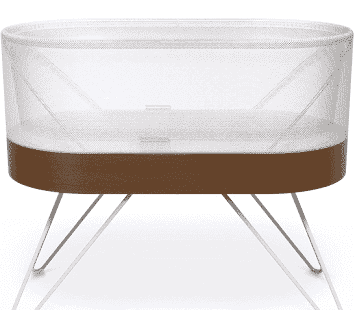As most everyone who’s experienced life with a newborn can attest, there will be times when you’re sleep deprived. There’s no getting around some of this: newborns need to eat every few hours, and it’s not like they can raid the fridge and see what’s there to snack on. While all babies have to eat, some babies, for any number of reasons, are up every hour or so, and require some parental attention before they can get soothed back into the Land of Nod. It’s been a long while – my three kids are all grown – but I can still remember how excited my wife and I were when each of our babies almost, sorta, kinda slept through the night.
And now there’s the Snoo, a $1,500 AI-robotic bassinet that helps babies (and their folks) get some much-needed sleep. The Snoo wasn’t around when I was a new dad, but – although I’m just reading about it now (no grandkids yet!) – it’s been available for a few years now.
It starts off with the first principle that a baby should be sleeping on its back, not face-down of on its side, which were the practices in earlier generations that, in fact, lead to many SIDS deaths. A Snoo baby is swaddled – another practice that’s recommended for newborns – in a little Snoo sack that has “wings” with clips that attach it to the sides of the bassinet. So: no rollovers.
Then there’s the technology.
The Snoo is equipped with sensors that detect when your baby is fussing. It responds by rocking the cradle and playing some white noise. If the baby continues to fuss, the levels of motion and white noise scale up. If the Snoo decides that its approach isn’t working, it sends an alert to the parents’ smartphone, so they can come and check on the baby, see if it’s hungry, or needs a diaper change, or just a real live human parental being to rub its tummy for a bit. The Snoo has protections built in that keep the motor from rocking the bassinet too aggressively. And there are software controls on volume maximums that limit the white noise volume. If you’re worried about hackers deciding to rock your baby from afar, Wi-Fi can be disabled.
Reading about the Snoo reminded me that, a few years ago, smart diapers were introduced. These (needless to say expensive) diapers were equipped with an embedded moisture sensor that sent out an alert when it detected dampness. I don’t know whether smart diapers took off at all. It sure seemed to me like an application looking for a reason for being. Certainly in my experience, babies have a pretty good way of signaling that they’re uncomfortably wet: they cry.
A baby stays in the Snoo until they’re six months old, the age when babies typically graduate to a crib. Snoo babies don’t go cold turkey. There’s a transition period when the babies learn to rely on their own self-soothing, rather than on the Snoo.
Anyway, while I may think that smart diapers were frivolous, I have a different take on the Snoo.
Sure, it’s expensive: $1,500 for a bassinet that’s going to be used for six months is a lot of money. Even if you hang on to it for later kids, it’s still a hefty original outlay, especially when you consider how many other items new parents need to acquire. (There are rental options for Snoos, as well as a secondary market on Craigslist.) But for those who can afford it, something that not only helps keep babies safe, but also gives parents a bit more sleep when they so desperately need it, seems like a good thing. Especially if you have a fussy baby – is the word “colicky” still used? – it sounds like a godsend.
That’s my initial opinion, anyway. I guess we’ll really find out what I think about it when we start having grandkids!
——————————————————————-
Sources for this post: Washington Post and Wired.
